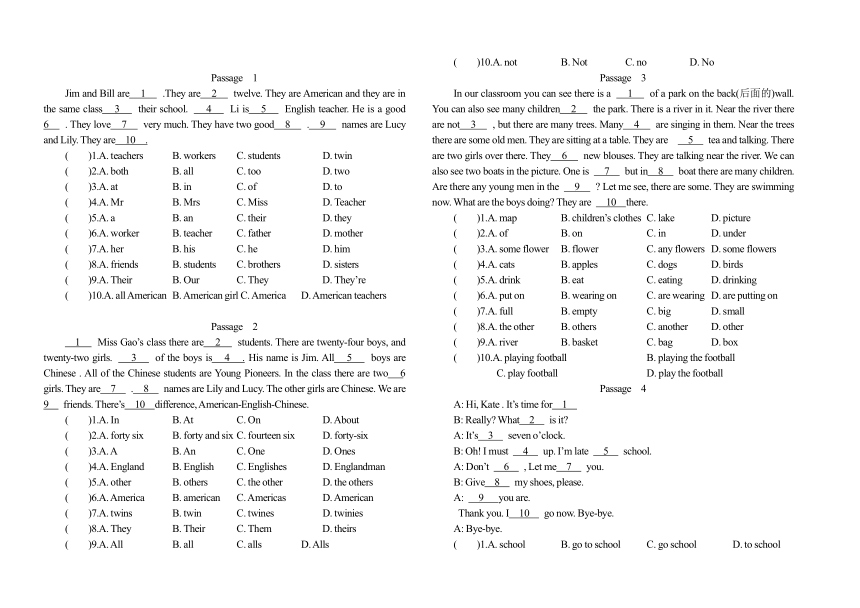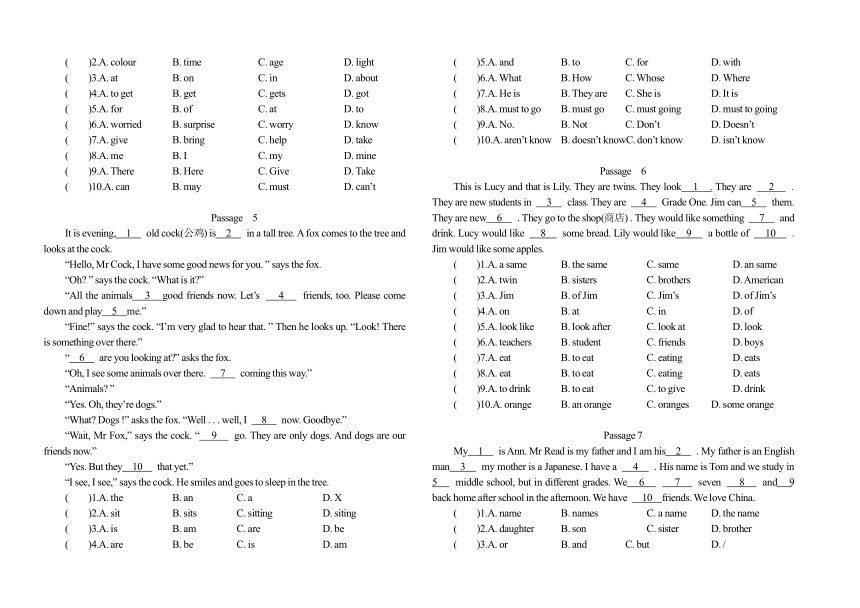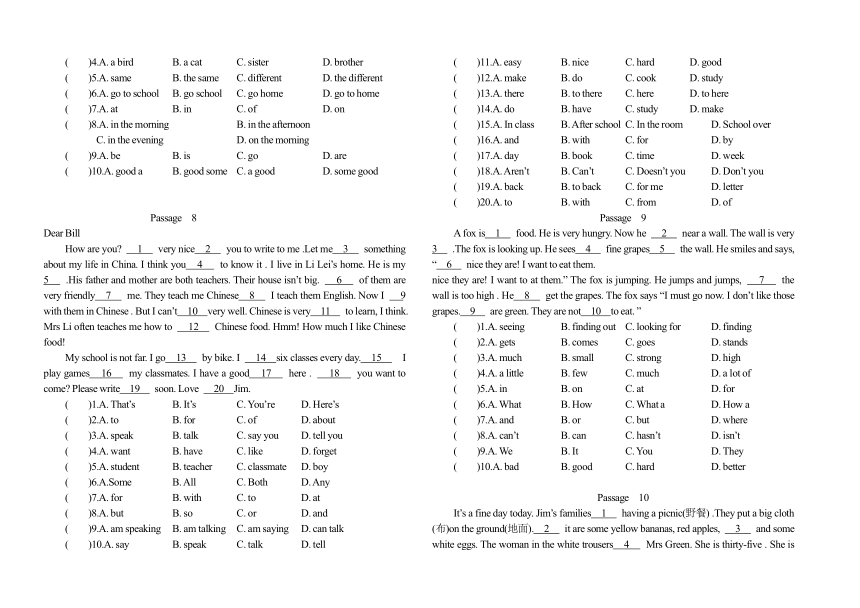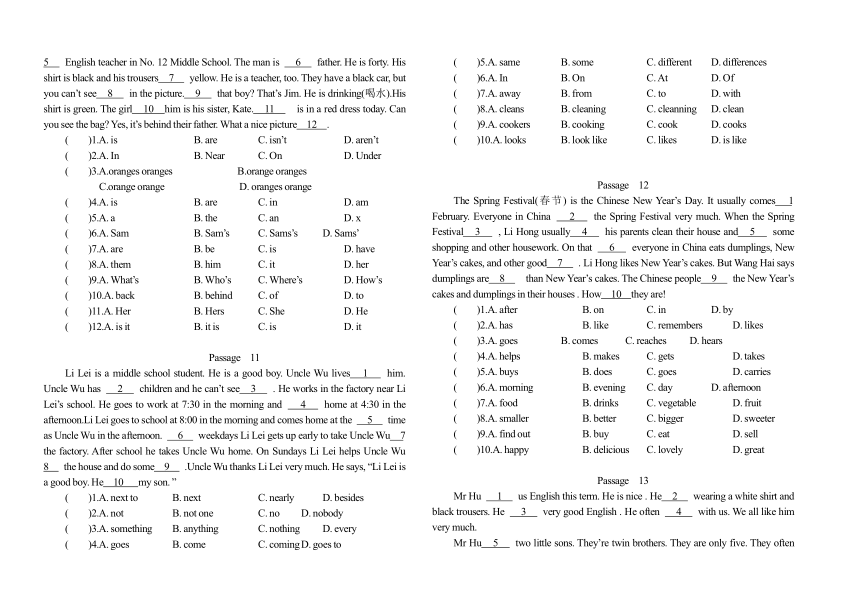通用小升初专区六年级英语完形填空15篇(含答案和讲解)
文档属性
| 名称 | 通用小升初专区六年级英语完形填空15篇(含答案和讲解) |  | |
| 格式 | zip | ||
| 文件大小 | 22.9KB | ||
| 资源类型 | 教案 | ||
| 版本资源 | 通用版 | ||
| 科目 | 英语 | ||
| 更新时间 | 2020-03-11 15:24:47 | ||
图片预览




文档简介
Passage 1
Jim and Bill are 1 .They are 2 twelve. They are American and they are in the same class 3 their school. 4 Li is 5 English teacher. He is a good 6 . They love 7 very much. They have two good 8 . 9 names are Lucy and Lily. They are 10 .
( )1.A. teachers B. workers C. students D. twin
( )2.A. both B. all C. too D. two
( )3.A. at B. in C. of D. to
( )4.A. Mr B. Mrs C. Miss D. Teacher
( )5.A. a B. an C. their D. they
( )6.A. worker B. teacher C. father D. mother
( )7.A. her B. his C. he D. him
( )8.A. friends B. students C. brothers D. sisters
( )9.A. Their B. Our C. They D. They’re
( )10.A. all American B. American girl C. America D. American teachers
Passage 2
1 Miss Gao’s class there are 2 students. There are twenty-four boys, and twenty-two girls. 3 of the boys is 4 . His name is Jim. All 5 boys are Chinese . All of the Chinese students are Young Pioneers. In the class there are two 6 girls. They are 7 . 8 names are Lily and Lucy. The other girls are Chinese. We are 9 friends. There’s 10 difference, American-English-Chinese.
( )1.A. In B. At C. On D. About
( )2.A. forty six B. forty and six C. fourteen six D. forty-six
( )3.A. A B. An C. One D. Ones
( )4.A. England B. English C. Englishes D. Englandman
( )5.A. other B. others C. the other D. the others
( )6.A. America B. american C. Americas D. American
( )7.A. twins B. twin C. twines D. twinies
( )8.A. They B. Their C. Them D. theirs
( )9.A. All B. all C. alls D. Alls
( )10.A. not B. Not C. no D. No
Passage 3
In our classroom you can see there is a 1 of a park on the back(后面的)wall. You can also see many children 2 the park. There is a river in it. Near the river there are not 3 , but there are many trees. Many 4 are singing in them. Near the trees there are some old men. They are sitting at a table. They are 5 tea and talking. There are two girls over there. They 6 new blouses. They are talking near the river. We can also see two boats in the picture. One is 7 but in 8 boat there are many children. Are there any young men in the 9 ? Let me see, there are some. They are swimming now. What are the boys doing? They are 10 there.
( )1.A. map B. children’s clothes C. lake D. picture
( )2.A. of B. on C. in D. under
( )3.A. some flower B. flower C. any flowers D. some flowers
( )4.A. cats B. apples C. dogs D. birds
( )5.A. drink B. eat C. eating D. drinking
( )6.A. put on B. wearing on C. are wearing D. are putting on
( )7.A. full B. empty C. big D. small
( )8.A. the other B. others C. another D. other
( )9.A. river B. basket C. bag D. box
( )10.A. playing football B. playing the football
C. play football D. play the football
Passage 4
A: Hi, Kate . It’s time for 1
B: Really? What 2 is it?
A: It’s 3 seven o’clock.
B: Oh! I must 4 up. I’m late 5 school.
A: Don’t 6 , Let me 7 you.
B: Give 8 my shoes, please.
A: 9 you are.
Thank you. I 10 go now. Bye-bye.
A: Bye-bye.
( )1.A. school B. go to school C. go school D. to school
( )2.A. colour B. time C. age D. light
( )3.A. at B. on C. in D. about
( )4.A. to get B. get C. gets D. got
( )5.A. for B. of C. at D. to
( )6.A. worried B. surprise C. worry D. know
( )7.A. give B. bring C. help D. take
( )8.A. me B. I C. my D. mine
( )9.A. There B. Here C. Give D. Take
( )10.A. can B. may C. must D. can’t
Passage 5
It is evening, 1 old cock(公鸡) is 2 in a tall tree. A fox comes to the tree and looks at the cock.
“Hello, Mr Cock, I have some good news for you. ” says the fox.
“Oh? ” says the cock. “What is it?”
“All the animals 3 good friends now. Let’s 4 friends, too. Please come down and play 5 me.”
“Fine!” says the cock. “I’m very glad to hear that. ” Then he looks up. “Look! There is something over there.”
“ 6 are you looking at?” asks the fox.
“Oh, I see some animals over there. 7 coming this way.”
“Animals? ”
“Yes. Oh, they’re dogs.”
“What? Dogs !” asks the fox. “Well . . . well, I 8 now. Goodbye.”
“Wait, Mr Fox,” says the cock. “ 9 go. They are only dogs. And dogs are our friends now.”
“Yes. But they 10 that yet.”
“I see, I see,” says the cock. He smiles and goes to sleep in the tree.
( )1.A. the B. an C. a D. X
( )2.A. sit B. sits C. sitting D. siting
( )3.A. is B. am C. are D. be
( )4.A. are B. be C. is D. am
( )5.A. and B. to C. for D. with
( )6.A. What B. How C. Whose D. Where
( )7.A. He is B. They are C. She is D. It is
( )8.A. must to go B. must go C. must going D. must to going
( )9.A. No. B. Not C. Don’t D. Doesn’t
( )10.A. aren’t know B. doesn’t knowC. don’t know D. isn’t know
Passage 6
This is Lucy and that is Lily. They are twins. They look 1 . They are 2 . They are new students in 3 class. They are 4 Grade One. Jim can 5 them. They are new 6 . They go to the shop(商店) . They would like something 7 and drink. Lucy would like 8 some bread. Lily would like 9 a bottle of 10 . Jim would like some apples.
( )1.A. a same B. the same C. same D. an same
( )2.A. twin B. sisters C. brothers D. American
( )3.A. Jim B. of Jim C. Jim’s D. of Jim’s
( )4.A. on B. at C. in D. of
( )5.A. look like B. look after C. look at D. look
( )6.A. teachers B. student C. friends D. boys
( )7.A. eat B. to eat C. eating D. eats
( )8.A. eat B. to eat C. eating D. eats
( )9.A. to drink B. to eat C. to give D. drink
( )10.A. orange B. an orange C. oranges D. some orange
Passage 7
My 1 is Ann. Mr Read is my father and I am his 2 . My father is an English man 3 my mother is a Japanese. I have a 4 . His name is Tom and we study in 5 middle school, but in different grades. We 6 7 seven 8 and 9 back home after school in the afternoon. We have 10 friends. We love China.
( )1.A. name B. names C. a name D. the name
( )2.A. daughter B. son C. sister D. brother
( )3.A. or B. and C. but D. /
( )4.A. a bird B. a cat C. sister D. brother
( )5.A. same B. the same C. different D. the different
( )6.A. go to school B. go school C. go home D. go to home
( )7.A. at B. in C. of D. on
( )8.A. in the morning B. in the afternoon
C. in the evening D. on the morning
( )9.A. be B. is C. go D. are
( )10.A. good a B. good some C. a good D. some good
Passage 8
Dear Bill
How are you? 1 very nice 2 you to write to me .Let me 3 something about my life in China. I think you 4 to know it . I live in Li Lei’s home. He is my 5 .His father and mother are both teachers. Their house isn’t big. 6 of them are very friendly 7 me. They teach me Chinese 8 I teach them English. Now I 9 with them in Chinese . But I can’t 10 very well. Chinese is very 11 to learn, I think. Mrs Li often teaches me how to 12 Chinese food. Hmm! How much I like Chinese food!
My school is not far. I go 13 by bike. I 14 six classes every day. 15 I play games 16 my classmates. I have a good 17 here . 18 you want to come? Please write 19 soon. Love 20 Jim.
( )1.A. That’s B. It’s C. You’re D. Here’s
( )2.A. to B. for C. of D. about
( )3.A. speak B. talk C. say you D. tell you
( )4.A. want B. have C. like D. forget
( )5.A. student B. teacher C. classmate D. boy
( )6.A.Some B. All C. Both D. Any
( )7.A. for B. with C. to D. at
( )8.A. but B. so C. or D. and
( )9.A. am speaking B. am talking C. am saying D. can talk
( )10.A. say B. speak C. talk D. tell
( )11.A. easy B. nice C. hard D. good
( )12.A. make B. do C. cook D. study
( )13.A. there B. to there C. here D. to here
( )14.A. do B. have C. study D. make
( )15.A. In class B. After school C. In the room D. School over
( )16.A. and B. with C. for D. by
( )17.A. day B. book C. time D. week
( )18.A. Aren’t B. Can’t C. Doesn’t you D. Don’t you
( )19.A. back B. to back C. for me D. letter
( )20.A. to B. with C. from D. of
Passage 9
A fox is 1 food. He is very hungry. Now he 2 near a wall. The wall is very 3 .The fox is looking up. He sees 4 fine grapes 5 the wall. He smiles and says, “ 6 nice they are! I want to eat them.
nice they are! I want to at them.” The fox is jumping. He jumps and jumps, 7 the wall is too high . He 8 get the grapes. The fox says “I must go now. I don’t like those grapes. 9 are green. They are not 10 to eat. ”
( )1.A. seeing B. finding out C. looking for D. finding
( )2.A. gets B. comes C. goes D. stands
( )3.A. much B. small C. strong D. high
( )4.A. a little B. few C. much D. a lot of
( )5.A. in B. on C. at D. for
( )6.A. What B. How C. What a D. How a
( )7.A. and B. or C. but D. where
( )8.A. can’t B. can C. hasn’t D. isn’t
( )9.A. We B. It C. You D. They
( )10.A. bad B. good C. hard D. better
Passage 10
It’s a fine day today. Jim’s families 1 having a picnic(野餐) .They put a big cloth (布)on the ground(地面). 2 it are some yellow bananas, red apples, 3 and some white eggs. The woman in the white trousers 4 Mrs Green. She is thirty-five . She is 5 English teacher in No. 12 Middle School. The man is 6 father. He is forty. His shirt is black and his trousers 7 yellow. He is a teacher, too. They have a black car, but you can’t see 8 in the picture. 9 that boy? That’s Jim. He is drinking(喝水).His shirt is green. The girl 10 him is his sister, Kate. 11 is in a red dress today. Can you see the bag? Yes, it’s behind their father. What a nice picture 12 .
( )1.A. is B. are C. isn’t D. aren’t
( )2.A. In B. Near C. On D. Under
( )3.A.oranges oranges B.orange oranges
C.orange orange D. oranges orange
( )4.A. is B. are C. in D. am
( )5.A. a B. the C. an D. x
( )6.A. Sam B. Sam’s C. Sams’s D. Sams’
( )7.A. are B. be C. is D. have
( )8.A. them B. him C. it D. her
( )9.A. What’s B. Who’s C. Where’s D. How’s
( )10.A. back B. behind C. of D. to
( )11.A. Her B. Hers C. She D. He
( )12.A. is it B. it is C. is D. it
Passage 11
Li Lei is a middle school student. He is a good boy. Uncle Wu lives 1 him. Uncle Wu has 2 children and he can’t see 3 . He works in the factory near Li Lei’s school. He goes to work at 7:30 in the morning and 4 home at 4:30 in the afternoon.Li Lei goes to school at 8:00 in the morning and comes home at the 5 time as Uncle Wu in the afternoon. 6 weekdays Li Lei gets up early to take Uncle Wu 7 the factory. After school he takes Uncle Wu home. On Sundays Li Lei helps Uncle Wu 8 the house and do some 9 .Uncle Wu thanks Li Lei very much. He says, “Li Lei is a good boy. He 10 my son. ”
( )1.A. next to B. next C. nearly D. besides
( )2.A. not B. not one C. no D. nobody
( )3.A. something B. anything C. nothing D. every
( )4.A. goes B. come C. coming D. goes to
( )5.A. same B. some C. different D. differences
( )6.A. In B. On C. At D. Of
( )7.A. away B. from C. to D. with
( )8.A. cleans B. cleaning C. cleanning D. clean
( )9.A. cookers B. cooking C. cook D. cooks
( )10.A. looks B. look like C. likes D. is like
Passage 12
The Spring Festival(春节) is the Chinese New Year’s Day. It usually comes 1 February. Everyone in China 2 the Spring Festival very much. When the Spring Festival 3 , Li Hong usually 4 his parents clean their house and 5 some shopping and other housework. On that 6 everyone in China eats dumplings, New Year’s cakes, and other good 7 . Li Hong likes New Year’s cakes. But Wang Hai says dumplings are 8 than New Year’s cakes. The Chinese people 9 the New Year’s cakes and dumplings in their houses . How 10 they are!
( )1.A. after B. on C. in D. by
( )2.A. has B. like C. remembers D. likes
( )3.A. goes B. comes C. reaches D. hears
( )4.A. helps B. makes C. gets D. takes
( )5.A. buys B. does C. goes D. carries
( )6.A. morning B. evening C. day D. afternoon
( )7.A. food B. drinks C. vegetable D. fruit
( )8.A. smaller B. better C. bigger D. sweeter
( )9.A. find out B. buy C. eat D. sell
( )10.A. happy B. delicious C. lovely D. great
Passage 13
Mr Hu 1 us English this term. He is nice . He 2 wearing a white shirt and black trousers. He 3 very good English . He often 4 with us. We all like him very much.
Mr Hu 5 two little sons. They’re twin brothers. They are only five. They often 6 the same clothes. 7 Betty goes to Mr Hu’s home. She loves to 8 the twins and play with 9 . Mr Hu 10 his sons, Bao Bao and Bei Bei.
( )1.A. tells B. teaches C. speaks D. works
( )2.A. is B. likes C. want D. does
( )3.A. speaks B. says C. tells D. teaches
( )4.A. says B. speaks C. talks D. tells
( )5.A. wants B. has C. looks after D. teaches
( )6.A. wear B. put on C. have D. in
( )7.A. But B. And C. Then D. Sometimes
( )8.A. look B. think C. take D. see
( )9.A. twins B. ones C. they D. them
( )10.A. calls B. name C. thinks D. think
Passage 14
What do you do at the weekend ? Some people like to 1 at home, but others like to go 2 a walk or play football. My friends Jack works hard in a factory during the 3 . At the weekend, he always 4 the same thing. On Saturday he 5 his car and on 6 he goes with his family to a village by car. His uncle and aunt have a farm there. It isn’t a 7 one, but there’s always 8 to do on a farm. The children help with the animals and give them their 9 . Jack and his wife help in the fields . At the end of the day, they are all 10 and Jack’s aunt gives them a big meal.
( )1.A. play B. stay C. live D. enjoy
( )2.A. to B. in C. at D. for
( )3.A. day B. time C. autumn D. weekdays
( )4.A. does B. make C. borrows D. has
( )5.A. watches B. washes C. driving D. sells
( )6.A. Monday B. Saturday C. Sunday D. Tuesday
( )7.A. big B. small C. hard D. short
( )8.A. little B. much C. fast D. far
( )9.A. clothes B. places C. food D. balls
( )10.A. clean B. late C. hungry D. friendly
Passage 15
Do you want to know my family? Let 1 tell you. My 2 is in Huangshan. There 3 people in my family, 4 . My father’s name 5 Wang Dong. He is forty-five years old . He 6 young. He is 7 Chinese teacher, but he 8 English. 9 students think he is a good teacher. He loves me and I love him, 10 . I think he is a good 11 . My mother’s name is Li Ying. She is a worker. She is a very good worker 12 mother. My name is Wang Feng. I’m thirteen. I’m a boy. I 13 in a middle school. The school is 14 my home. Sometimes I go to school 15 . I study hard.
( )1.A. I B. we C. me D. us
( )2.A. house B. home C. study D. work
( )3.A. are three B. is three C. are two D. is two
( )4.A. my father, I and my mother B. my father, my mother and I
C. my mother, my father and me D. I, my father and my mother
( )5.A. is B. has C. are D. have
( )6.A. look B. is C. looks D. likes
( )7.A. the B. an C. 不填 D. a
( )8.A. know B. knows C. is knowing D. knowing
( )9.A. Their B. His C. My D. He’s
( )10.A. too B. to C. two D. OK
( )11.A. student B. worker C. teacher D. boy
( )12.A. for B. and C. but D. or
( )13.A. work B. lives C. study D. teach
( )14.A. near B. to C. on D. in
( )15.A. play B. by bike C. on bike D. bikes
答案与提示
答案与提示: Passage 1
1. C 由下文 They are twelve,确定他们不可能是teachers, workers,而选项D没有加s,因此只能选C。
2. A both是“两者都”之意,用于be 动词之后。B项all是三者、三者以上“都”,选项C、D都不合题意。
3. B “在学校”可用at school,但school前有修饰词a或one’s 介词要用in.
4. A 由下文He确定老师是男性,B项Mrs是“夫人”之意,C项Miss“女士”“小姐”均为女性,选项D为teacher,英语中对老师的称呼用Miss或Mr加姓,不能用汉语直译。
5. C 由上下文判断此处应用物主代词 their“他们的”。如:李老师可说Miss Li, Mr Li而不能用Teacher Li.
6. B 由文中知道He是老师。
7. D him“他”是句子宾语,应用代词的宾格形式,四个选项中只有D为宾格。
8. A 根据下文可知本句应是他们有两位好朋友。
9. A “名字叫……”names前要加物主代词their,句首要大写。
10.A 此题用排除法。选项D是美国老师们,而这些孩子是学生不可能是老师,选项C是国家名词“美国”,B项American后面的名词未加s,且四个孩子不都是女孩。只有选项A适合题意,意为“他们都是美国人”。
答案与提示: Passage 2
1. A In Miss Gao’s class意为“在高小姐的班上。”
2. D 基数词表示几十几时,先说几十,再说几,中间要加短横。
3. C One of…表示“…之一”
4. B English 可以作为形容词直接放在be动词后面作表语,意为“英国人”。主语可以是单数,也可以是复数。
5. C the other可以修饰复数名词,表示除前面提到的以外的“全部其余的”。
6. D 修饰名词用形容词American .A项为名词意为“美国”。B项没大写,C项为错误表达法。
7. A 句子单复数保持一致。
8. B 名词前面要用形容词性物主代词作定语。they为主格作主语。B项为形容词性物主代词作定语。C项为宾格作宾语。D项为名词性物主代词可作主语、宾语、表语。
9. B all为副词,没有单复数变化形式。
10.C no用作形容词时,可直接置于名词前面。但如果前面已有a, this ,his much, any等词时,则用not.
答案与提示: Passage 3
1. D a picture of a park意为“一幅公园的画。”
2. C in the park。意为“在公园里。”
3. C any 用于否定句或疑问句。some用于肯定句。
4. D 能够在树上唱歌的应是鸟,而不是其它三项猫、苹果、狗。
5. D 表示喝茶用drink,不用eat。另外,and前后的谓语动词形式要一致,所以drink要加-ing,构成现在进行时。
6. C wear是“穿着”,“戴着”,强调状态,用现在进行时表示此刻的状态。Put on是“穿上”、“戴上”,强调动作。
7. B 根据下文在另一只船里有许多孩子们表转折关系,说明本句应是一只船是空的。
8. A 表示两者范围之内“一个是……,另一个是……”用one is …,the other is …
9. A 下文说有一些人在游泳,说明本句应问在河里有一些年轻人吗?
10.A 球类运动前不要冠词
答案与提示: Passage 4
1. A It’s time for school. 意为“是该上学的时候了。”
2. B 下句回答了时间,说明本句应提问时间用What time.
3. D about意为“大约”。
4. B must为情态动词,其后面的动词要用原形。
5. A 固定词组be late for意为“迟到”。
6. C Don’t worry意为“别担心”。本句为祈使句的否定式。
7. C Let me help you意为“让我帮助你”。
8. A give为动词,其后面的代词要用宾格形式。
9. B Here you are,意为“给你”。
10.C 根据上文,此处应用must表示“必须”。
答案与提示: Passage 5
1. B an 用在发元音音素开头的单词前。
2. C 横线前已有is,故选 sitting构成现在进行时,它的结构是:主语+be+动词的现在分词+其它。Sit 的现在分词要双写t再加ing.
3. C 主语All the animals为复数。谓语动词用are.
4. B 以 Let开头的祈使句常用来表示说话人的建议、请求、命令等。Let 后面的不定式必须省去符号to.
5. D play with me表示“和我一起玩。”
6. A What问“什么”How问“怎样”Whose问“谁的”Where问“哪儿”。
7. B 根据前一句:“I see some animals over there”本句应为“它们正朝这边过来。”
8. B must 意思是“必须”是情态动词,它后面的动词用原形。
9. C 本句祈使句的否定式,其结构为:Don’t +V原形+其它。
10.C 本句为非be动词的一般现在时结构。其动词的构成是:don’t +V原形。
答案与提示: Passage 6
1. B 固定词组look the same意为“看起来很像”。
2. B Lucy和Lily为女孩名又是双胞胎,所以她们应是姐妹关系。
3. C 名词加“s”表示有生命的东西的名词所有格。
4. C 表示在哪个年级,班级用介词in.
5. B look after意为“照顾,照看”,look like意为“看起来像”,look at意为“看……”look意为“看”。
6. C 本句是说Jim和双胞胎两个是好朋友。
7. B something to eat意为“一些吃的东西。” something to drink表示“一些喝的东西”,两者均为不定式作定语时放在所修饰词的后面。
8. B would like后面接不定式,即: would like to do sth.意为“想要干某事。”
9. A eat表示“吃”,drink表示“喝”。
10.A 瓶子装的应是桔汁而不是桔子。orange作“桔汁”讲时,为不可数名词,前面不可用不定冠词修饰,也不能加s.
答案与提示: Passage 7
1. A
2. A
3. C
4. D
5. B
6. A
7. A
8. A
9. C
10. D
答案与提示: Passage 8
1. B 动词不定式作主语时,常常用it作形式主语,放在句子的开头,把动词不定式放在谓语的后面,但翻译时不必译出来。
2. C it作形式主语时,如果形容词是表达不定式逻辑主语的性质用of。如果修饰不定式的动作用for.
3. D tell的意思是“告诉”,后面跟宾语或双宾 语结构。常用于tell sb (to do) sth结构。 say后面不能跟双宾 语结构, speak后接表示语言类的词。talk意为“谈话”“交谈”指相互之间的的谈话。
4. A want意为“想要”常用于句型want (sb) to do sth.
5. C student意为“学生”,teacher 意为“老师”。classmate意为“同学”。boy意为“男孩”,根据上下文可知C项合适。
6. B 表示“三者或三者以上全都”用all,表示“两者全都”用both, some 和any均意思为“一些”,分别用于肯定句和否定句。
7. C 句型be friendly to sb意思是“对某人友好。”
8. D 连接两个并列句用and.
9. B talk with sb意为“和某人交谈”。
10.B speak的宾语往往是语言名词。
11.C 根据上句我英语说得不好,本句意思应是汉语对我来说很难。
12.C 表示做中国食物用cook,不用do, make. study表示“学习”。
13.A 固定搭配come here来这儿,go there去那儿。
14.B have classes意为“上课”。
15.B after school 表示放学后。
16.B with表示和“某人在一起”。
17.C 固定词组have a good time “玩得高兴。”
18.D 本句为一般疑问句的否定式即否定疑问句。
19.A write back soon意为“尽快回信”。
20.C from表示“来自…”
答案与提示: Passage 9
1. C 从第一句话中的单词food,我们可以推断:一只狐狸在找食物。
2. D 选项A: gets, B: comes, C: goes之后都应跟介词to+地点名词,而原句中所给的却是near,所以选择D。
3. D 从下文狐狸跳了又跳,可还是够不着,可以得出,这座墙很高。
4. D 这句中的名词grapes是复数形式。
5. B 表示“在…之上”用介词on,所以选择B 。
6. B 这句是感叹句,感叹句有两种形式:以What开始的感叹句,其后接名词短语;以How开始的感叹句,其后接形容词。此选项后是形容词nice,所以选择B。
7. C 这句是个转折句,他跳了又跳,可墙太高。
8. A 因为墙太高,他够不着葡萄。
9. D 这句的主语应指上句提到的葡萄grapes.
10.B 狐狸因为够不着葡萄,他说葡萄不好吃,所以选择B。
答案与提示: Passage 10
1. B family如果指一个家庭里的成员时,后面的动词要用复数形式。
2. C on it 指代on the big cloth.
3. B orange oranges意为“桔色的桔子”前一个orange是形容词指颜色,后一个orange作名词,意为“桔子。”
4. A 本句主语The woman in the white trousers意为“穿白色的裤子的那位女子”,是单数,所以系动词用is.
5. C an用在发元音音素开头的单词前。
6. B 表示有生命的东西的名词所有格用单数名词+’s.
7. A trousers 作主语时,谓语动词应用复数。
8. C 此处填it指代上句提到的a black car.
9. B Who用于问某人的姓名或某人与他人的关系。
10.B behind是表示方位的介词,意为“在……后面”。
11.C 本空要填作主语的人称代词She 指代The girl.
12.B 本句为一个感叹句。感叹句一般由What或How引导。What 用作定语修饰名词。How用作状语,修饰形容词,副词或动词。另外感叹句中的主谓要用陈述句的语序。
答案与提示: Passage 11
1. A next to him相当于near him 意为“在他附近”。
2. C no可用作形容词,也可用作副词,no用作形容词时,可直接置于名词前面。not只可用作副词,如果名词前面已有a, the ,his ,much, any等词时,则应在这些词前面用not.
3. B anything用于否定句和疑问句,something用于肯定句。
4. A go home意为“回家”,home为副词,前面不能要to
5. A at the same time在同一时间,same前面一般要加the.
6. B 表示在周日用on weekdays,在周末用on weekends.
7. C 固定用法take…to…,意为“把…带到…去”。
8. D help后面跟动词不定式作宾补时,可带to, 也可不带to,即句型:help sb (to) do sth.
9. B do some cooking是固定用法,意为“做饭”。
10.D 此处like为介词意为“像”,look like= be like.句子主语为第三人称单数,B项中的look like如果改为looks like也正确。
答案与提示: Passage 12
1. C 表示在某月用介词in.
2. D Everyone作主语时,当单数看待谓语动词要用动词的第三人称单数形式。
3. B 本句意思是当春节到来时。
4. A help his parents clean their house意为“帮助他的父母亲打扫房子”。
5. B and连接的两个并列谓语动词时态要一致。
6. C on that day.表示在那一天。
7. A 过年吃饺子,蛋糕和其它的食物。
8. B 黄海说饺子比新年的蛋糕更好,而不是A项(更小),C项(更大)D项(更甜)
9. C 本句意思是:中国人们在家吃新年的蛋糕和饺子。
10.A 这里的they指代The Chinese people,那么本句意思是他们多么快乐啊!
答案与提示: Passage 13
1. B 句型teach sb sth意为“教某人……”
2. A 此空填is补全现在进行时结构:主语+be+动词ing的形式。
3. A 说某种语言用speak.
4. C talk with sb表示“和某人交谈”。
5. B 表示某人有某物,主语是第三人称单数时,谓语动词用has.
6. A wear = be in表示“穿着”、“戴着”,强调状态。
7. D Sometimes意为“有时”,本句意思是贝蒂有时去胡先生的家。
8. D 此处see sb表示看望某人。
9. D with为介词后面要用代词的宾格形式。
10.A 此处call表示“称呼、叫”
答案与提示: Passage 14
1. B 与下文go for a walk or play football相对应,此处应用stay at home呆在家里,即B选项。
2. D go for a walk意为“外出散步”,为常用法,故本题选择D。
3. D 此句意为:我的朋友Jack在工作日努力在工厂工作。此处的weekdays是相对于下文的weekend而判断出的,故本题应选择D选项。
4. A 此句意为:他总是做同一件事。其英文表达应为“does the same thing”,即A选项。
5. B 此处应用谓语动词。C选项不正确;在其余三选项中washes符合句意“洗车,擦车”,故本题选B选项。
6. C 此处这一日子应是周末,即Saturday或Sunday, 而Saturday前文已叙述过,故此处应用Sunday, 即C选项。
7. A 本句意为:农场不大,但却有许多活要干。故此空应分别选择A选项。
8. B much 在本句中意为“许多”。
9. C 此处food符合题意,即“给动物喂食”,故本题应选择C选项。
10.C 由下文“Jack的姑妈给他们准备了丰盛的晚餐”,可以判定此处应用hungry,即C选项。
答案与提示: Passage 15
1. C
2. B
3. A
4. B
5. A
6. C
7. D
8. B
9. B
10. A
11. C
12. B
13. C
14. A
15. B
